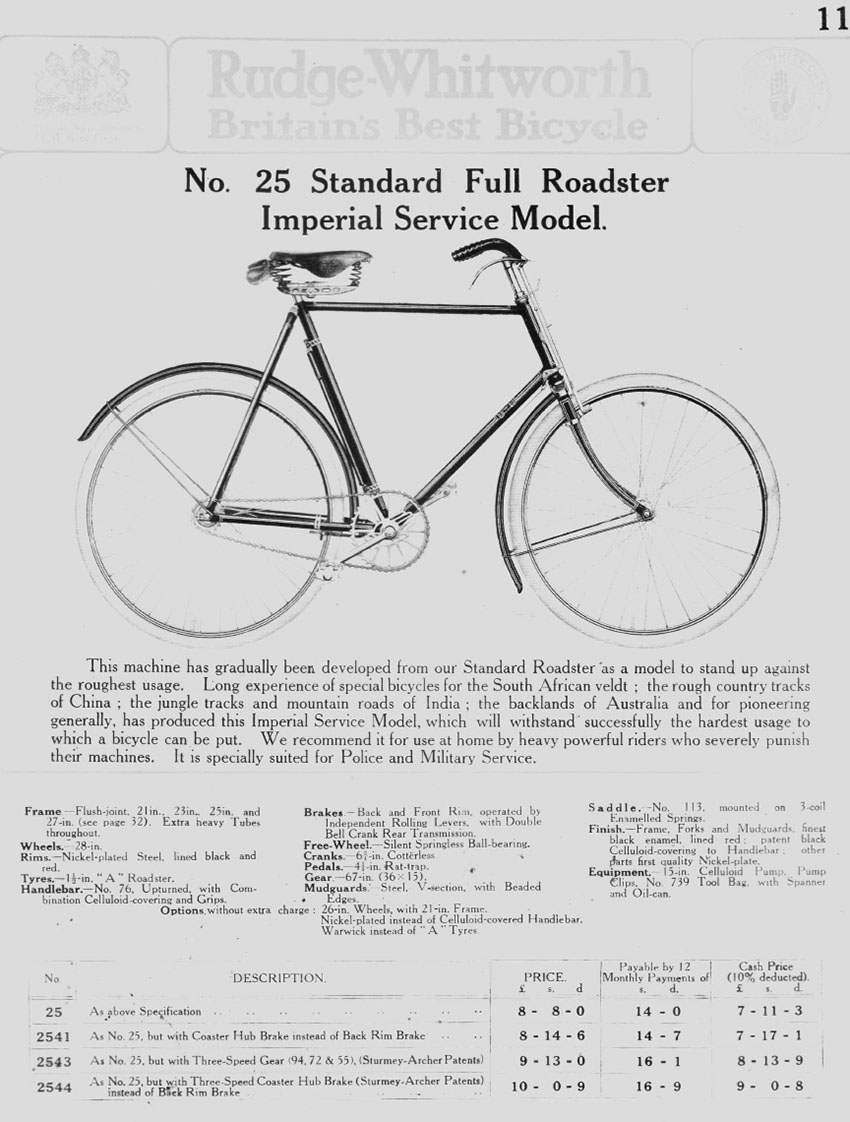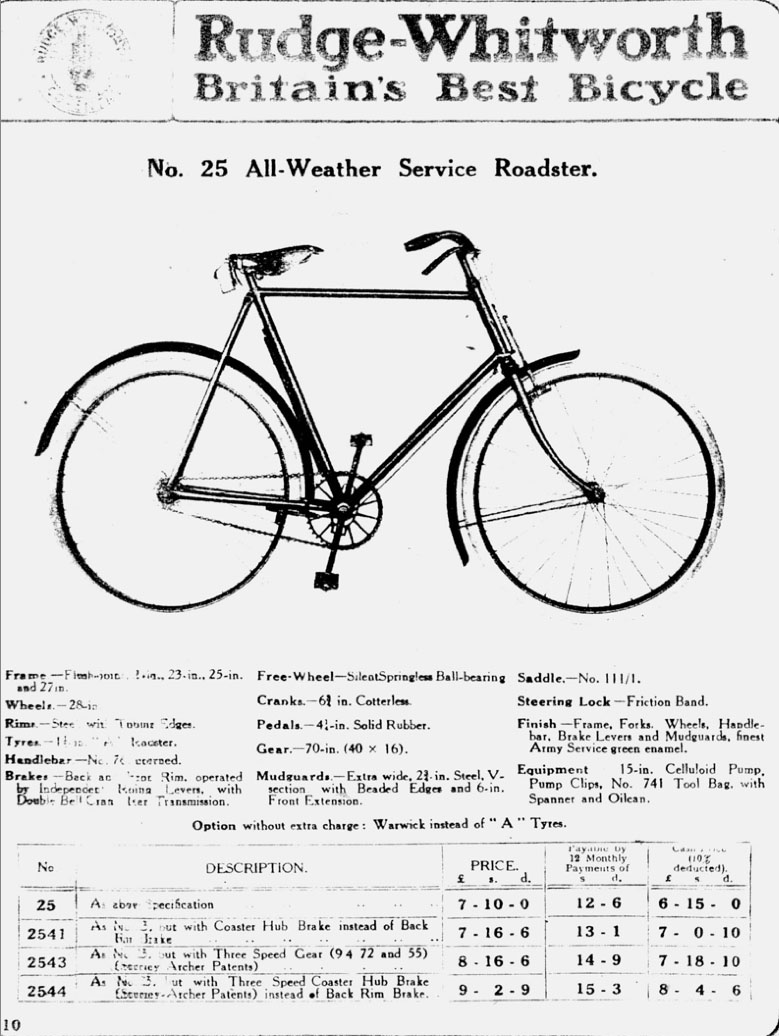

RUDGE-WHITWORTH BICYCLES of the 2/6th (CYCLIST) BATTALION, ROYAL SUSSEX REGIMENT
The 6th Battalion, The Royal Sussex Regiment, had its origins in the 1st Sussex Rifle Volunteers and the 1st Volunteer Battalion, The Royal Sussex Regiment. In 1908 the 1st Volunteer Battalion was disbanded and the 6th Battalion was formed primarily as cyclists of the new Territorial Force. During the First World War it in fact furnished three battalions, serving in coastal defence in England and in overseas service in Ireland and India.
World War I 1914 – 1918: The regiment raised 23 battalions for the war all of which saw action. The regiment had a battalion in every theatre including Russia in 1919. The regiment lost 7,302 men during the war and four Victoria Crosses were won by men from the regiment.
2nd Battalion: The 2nd Battalion crossed the channel with the British Expeditionary Force in 1914 and fought through the war on the Western Front. It was during the first Battle of Ypres that the 2nd Battalion was given the unofficial title ‘The Iron Regiment’ as an unsolicited testimonial by German prisoners captured on 1st November, 1914.
The Battalion subsequently fought alongside the 5th (Cinque Ports) Battalion during the Battle of Aubers Ridge on 9th May, 1915. Later that year, on 25th September, during the Battle of Loos, Sgt Harry Wells won a posthumous VC, when the Battalion took part in the attack in the vicinity of the Lone Tree in front of Hulluch. The Battalion moved to the Somme in 1916 where it was involved in actions including High Wood, moving back to the Ypres Sector in 1917. The battalion lost 1,723 officers and men killed by 1918.
Battle of the Boar’s Head: At Richebourg, in 1916, the 11th, 12th and 13th (Southdowns) Battalions of the Royal Sussex, made up the 116th Southdowns Brigade of the 39th Division in Kitchener’s New Army. On 30th June 1916 they took part in the Battle of the Boar’s Head, Richebourg L’Avoue. After a bombardment of the German trenches the 12th and 13th Battalions went over the top (most for the first time) and, under heavy fire, attacked the enemy trenches, bombing and bayoneting their way in. The 11th Battalion supplied carrying parties. They succeeded in taking the German front line trench, holding it for some four hours, and even briefly took the second line trench for about half an hour, beating off repeated counter attacks, and only withdrew from the shortage of ammunition and mounting casualties. Over a period of less than five hours the three Southdowns Battalions of The Royal Sussex lost 17 officers and 349 men killed, including 12 sets of brothers, including three from one family. A further 1000 men were wounded or taken prisoner. In the regiment history this is known as The Day Sussex Died. The following day the Battle of the Somme began and 20,000 died on the first day. The Royal Sussex attack at Richebourg was just a diversion, not even considered a separate action in the history of the war, and remain largely unmentioned in any of the official histories. There is a brilliant account of this in Edmund Blunden’s memoir ‘Undertones of War’ (he was an a 2nd Lieutenant in 11th Battalion).
Victoria Crosses during World War I:
- Sgt. Harry Wells (Posthumous in the Battle of Loos, 1915, while serving with the 9th Royal Sussex)
- Lt. Eric Archibald McNair (Hooge, Belgium)
- C.S.M. Nelson Victor Carter (Posthumous at Richebourg l’Avoue, France,1916)
- Lieut. Col. D.G Johnson (Crossing the Sambre Canal, November 1918)
While researching the 2/6th (Cyclist) Battalion, The Royal Sussex Regiment, I came across Dr Ray Bishop, whose father Jack served with the company in World War 1.
Ray has very kindly shared these photos of his father. Jack Bishop is on the right in the top photo and also in the photo below.

Most WW1 photos are poor quality and low resolution, and (unless a more distinctive folding model) it’s usually hard to determine the manufacturer of the bicycles pictured. However, the fine detail in Ray’s excellent photos of his father have allowed me to set up this Rudge-Whitworth Military Model in an identical style.
The top photo of the three cyclists also reveals the design of rifle clips (there were a number of variations used).
I took the Rudge-Whitworth to the Royal Sussex Regimental Museum at Redoubt Fortress in Eastbourne for these photos.


1914 Rudge-Whitworth ‘No 25’ Service Roadster
2/6th (Cyclist) Battalion, Royal Sussex Regiment
25″ Frame
28″ Wheels







The 1911 Rudge-Whitworth Service Model (top picture, with a soldier standing next to it) and the 1912 model, above, were painted black and had no mudguard extension. The Service Roadster, shown in the 1915 Rudge-Whitworth catalogue below, featured a front mudguard extension and was painted in ‘finest Army Service green enamel.’









ROYAL SUSSEX CYCLIST BATTALION

















ROYAL SUSSEX REGIMENTAL MUSEUM
REDOUBT FORTRESS, EASTBOURNE, EAST SUSSEX

Eastbourne Redoubt is a circular coastal defence fort built in 1805 as part of the anti-invasion preparations during the Napoleonic Wars. During World War One, the military police used it as a headquarters and temporary jail, and in the Second World War the army requisitioned the building for storage use. Canadian troops occupied it in the build up to the D-Day landings. It opened as a military museum in 1977, and is now the largest military museum in S.E England.



TO READ ABOUT
THE REDOUBT FORTRESS & MILITARY MUSEUM
PLEASE CLICK HERE


Introduction to the Royal Sussex Regiment thanks to:
– http://en.wikipedia.org/wiki/Royal_Sussex_Regiment
– http://apps.nationalarchives.gov.uk/a2a/records.aspx?cat=182-rsr&cid=1-7#1-7
Additional info thanks to – Colonel R.M Arnold, President, The Royal Sussex Regiment Association












































